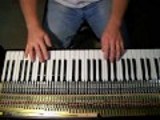When I set out to work on electric pianos, I established some ground rules for myself. I would only work on Rhodes Stage pianos and of those, only units I owned. So when a friend and local musician asked me to take a look at his Hohner Pianet T, my curiosity demanded that I subject my charter to a reevaluation. I’m glad I did as it’s turned out to be a fascinating little instrument.
With just sixty keys and a cabinet that’s only 3 1/2 inches tall, at just over 42 pounds, its weight is quite surprising. The Pianet’s tone is generated by metal reeds which vibrate in the presence of simple magnetic pickups. The reeds are mounted to a steel bar fully 3/8 of an inch thick which is also welded to another 1/4 inch steel bar. I believe that this extraordinary mass is helpful in aiding the reeds to vibrate enough to generate an acceptable tone.
The action, indeed the whole instrument, is dead-simple. Each key, both white and black, pivot on a common axle running the length of the piano. Return is effected by a pull-spring attached to the underside of the key just past the fulcrum. At the other end of the key are the hammers. Even though they’re called hammers, the silicone blocks actually work in a way opposite to a standard piano hammer. At rest, a Pianet hammer rests directly on the surface of its reed. When the key is depressed, the hammer lifts off the reed while the slightly tacky silicone tries to hang on just enough that it has the effect of plucking the reed. For this reason, the hammers are also commonly called “sticky pads”. When the key is released, the hammer mutes the reed eliminating the need for a separate damper mechanism.
It is these “sticky pads” that are a common point of failure on a Pianet. Over time, they can lose their tackiness and are easily damaged by heavy playing or careless handling. The pads on this piano look to be in very good shape but a few have definitely lost their ability to pluck a reed. Apparently the tack can be restored with a simple cleaning.
Although Pianets by design generate a very weak signal at the output jack, I suspect there’s another reason I was unable to get a decent sound out of this piano without significant amplification. What little tone it produced was polluted with far too much buzzing. I’ve seen the noise level cut significantly by grounding the metal key shafts and that may be all that is needed to clean this one up.


